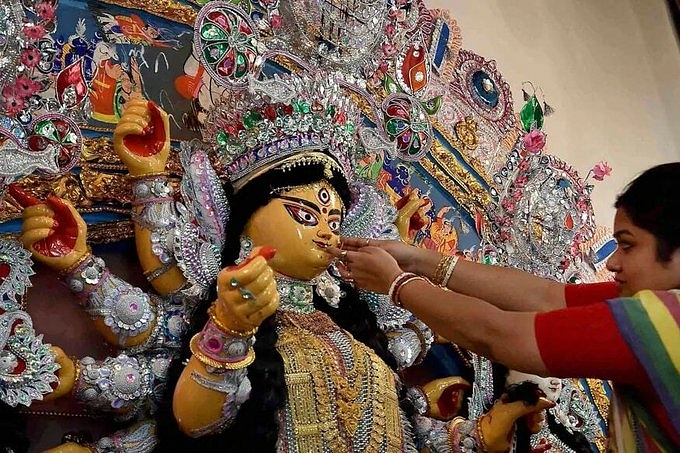Ideas
Random Meditations Through Her 1,000 Names (XIX): The Beauty Of Her Nose
- The forbidden champaka flower is compared to the nose of the goddess, who also wears it on her hair.
- This demonstrates how the goddess shows motherly compassion without reason or condition.

The goddess exhibits a divine form.
Read the previous part here.
From the eyes of the goddess, it is now her nose that we are describing. And the Sahasranama calls her as the one whose nose is similar to the newly-blossomed champaka flower: Navachampaka pushpabha nasasdanda virajita.
Here, her nose is compared to the newly-blossomed champaka flower. Smell is the sense associated with the nose, and the newly-blossomed champaka flowers are highly fragrant. Thus, by associating the nose of the goddess with champaka, a positive and divine sensory element is created.
The champaka itself is characteristic of the goddess. In the very first verse of "Ardhanari Nateshvara Stotram", a hymn to half-feminine master of dance attributed to Adi Shankaracharya, one half of the deity belonging to the goddess is depicted as sporting the golden yellow hue of the champaka flower.
The champaka flowers are associated with Kama. One of the five floral arrows which Manmada carries is that of the champaka flower. Pradhymna, who is also considered as the incarnation of Kama, is worshipped with champaka flowers along with vilva leaves.
Apart from this, there is another puranic association which is quite significant to Sri Lalita Sahasranama.
In the description of the burning of Kama by Shiva in Vamana Purana, when Shiva looked at Kama with anger the latter realised his body was burning from the feet up. Then he threw down his bow. The bow broke into five pieces. They became the fragrant champaka tree, the kesar forest (kesararanya) or Bakula forest, the patala, the five-petalled white jasmine, and mallika flowers.
Of these, it was “the hilt of the bow which being covered with gold was highly lustrous was transformed into Campaka tree, rich in fragrance and equally charming in form”. (Vamana Purana - 6:98).
However, the flower is invoked with respect to the goddess not only as the first flower in her hair but also compared to her nose. It is well-known that the goddess is the one who shows motherly compassion without any reason or condition.
Surely, one of the last names, the 992nd, declares her so: Avyaja karunamurti . She does not care whether the one who receives her compassion is worthy or not. Her compassion just flows.
This aspect of the divine feminine is well demonstrated by Sri Sarada Devi, the holy mother of Sri Ramakrishna-Vivekananda Vedanta tradition.
Sri Ramakrishna was strict about the rules of spiritual sadhana. So, when a woman one day requested Sarada Devi to allow her to hand over a plate of food to Sri Ramakrishna, Sarada Devi consented.
After the woman left and the master sat down to eat, he found it difficult to eat that meal. He asked why she handed over the plate to a woman who was said to be leading an immoral life. Sarada Devi said she knew all about that. But she requested Ramakrishna to have the food.
Swami Gambhirananda writes:
Sarada Devi declared that she was not only the mother of the good and pious but also the mother of the bad and fallen.
This compassion of the divine feminine is exhibited here in the very commencement of the description of the goddess’ form when in her hair we find the champaka that had arisen from the broken bow of Kama, and in the mention of the flower in the Sahasranama comparing her nose to it.
With her, the liberation is possible for all what has been explicitly stated in the 992nd name. This has been shown in the very elements present in her divine form in the thirteenth and nineteenth names.
Introducing ElectionsHQ + 50 Ground Reports Project
The 2024 elections might seem easy to guess, but there are some important questions that shouldn't be missed.
Do freebies still sway voters? Do people prioritise infrastructure when voting? How will Punjab vote?
The answers to these questions provide great insights into where we, as a country, are headed in the years to come.
Swarajya is starting a project with an aim to do 50 solid ground stories and a smart commentary service on WhatsApp, a one-of-a-kind. We'd love your support during this election season.
Click below to contribute.
Latest